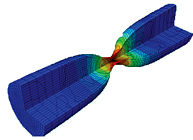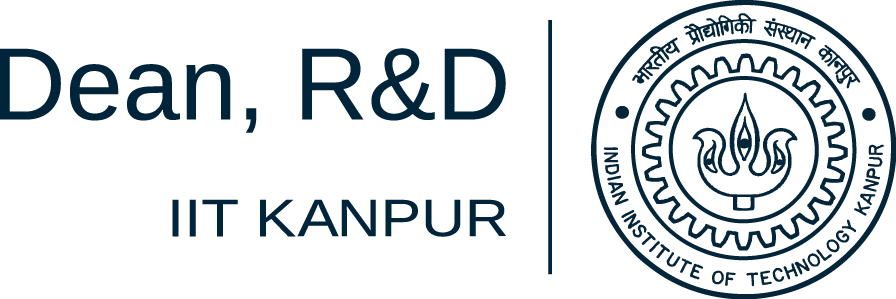- Publications
- Centers & Facilities
- Centers
- Advanced Center for Material Science
- Center for Environmental Science & Engineering
- Advance Center for Electronic System
- National Information Center of Earthquake Engineering
- BSNL-IITK Telecom Center of Excellence
- SAMTEL Center for Display Technology
- Center for Mechatronics
- Syndicate Bank Entrepreneurship Research & Training
- Center for Laser Technology
- Thematic Unit of Excellence
- Facilities
- Centers
- Innovation & Incubation
- Initiatives
- Industry Collaborations
- DORD Office
|
||||||
 |
An initiative on Mechanics and MaterialsIn a sense, mechanics, in particular, engineering mechanics is an established field. Major disciplines such as condensed matter physics, fluid dynamics, optics, nonlinear dynamics and structural mechanics stem from this source. Its utility, nay necessity, in almost any scientific or technological endeavor cannot be overstated. In a utilitarian context, the primary aim is to understand, follow, and ultimately predict critical macroscopic parameters such as peak stress or maximum temperature or largest deformation or highest current density or incipient failure of a mechanical system, given knowledge of its interaction with the environment, and the stress response (constitutive behavior) of the material composing the system. Even for materials whose constitutive law is well tested and compactly represented, characterizing it macroscopically for its response remains a far from trivial problem. Much remains to be done in the domains of both analytical and computational modeling. This is especially important today, as mechanics becomes a fundamental component in diverse fields spread across a wide range of length scales – from small-scale machines to space stations. There is an ever-growing requirement for detailed analyses, addressing complex loading patterns including non-mechanical interactions such as thermal or electromagnetic fields, incorporating actual geometry, and, most importantly, employing realistic material behavior (namely, the constitutive response). A material’s constitutive relationship depends critically on its micromechanical configuration. Vastly diverging macroscopic mechanical performance is often observed for disparate internal structures under the same operational conditions. Conversely, for a given internal structure, the structure response to steady and unsteady loading conditions could be quite different. Though numerical techniques such as FEM have evolved considerably to address complex configurations, they continue to be limited by the physical content present in the mathematical model. Micromechanical modeling, thus, emerges as the issue that needs to be urgently addressed in right earnest. With our growing ability to manipulate and assemble microstructures at different length scales, it is now becoming possible to design materials tailored to specific needs. Indeed, this has led to development of functionally graded materials, laminated composites, bio-polymers, and metallic crystals, to name a few. Knowledge of the micro-mechanics of such materials is essential to profitably utilize them. Unfortunately, a confirmed ability to extract a constitutive law based on a material’s micro-scale organization, and be able to predict its subsequent macroscopic impact, remains elusive and ill-understood. Moreover, while a mechanical system’s health is monitored via macroscopically accessible critical parameters, the seeds of failure lie in the material’s microstructure. Relating macroscopically measurable quantities to a material’s microstructure, a subject called multiscale modeling, continues to be a major challenge in the domain of engineering research. At IIT Kanpur, we have ongoing programs of research into analytical and computational constitutive modeling of microscopically complex materials, their development and, finally, experimental characterization. Examples of these include, amongst others, 1) predicting large-scale catastrophic instabilities in metals based on their underlying crystalline structure, 2) understanding damage and failure in polymers as functions of its polymeric identity, 3) developing and characterizing bio-inspired adhesives, 4) evolving designer, application-specific laminated composites, 5) experimental impact mechanics and 6) probing the constitutive behavior of complex fluids such as colloidal glasses. The above research is well supported by quality computational architecture, and excellent experimental facilities including Atomic Force Microscopy, 3-d Laser Doppler Vibrometer, Digital Image Correlation System, Micromachining Centre, Dynamic Mechanical Analyzer, Particle Imaging Velocimetry, and Hot iso-static press, to name select equipment. This expertise in material modeling, sharing a robust symbiotic relationship with a strong tradition in theoretical and applied mechanics, makes IIT Kanpur most advantageously placed in the country to conduct fundamental yet futuristic research in continuum mechanics. This IGCAR Cell wishes to explore the possibility of constituting in conjunction with Indira Gandhi Center for Atomic Research, Kalpakkam a formal mechanics and materials group at IIT Kanpur. This group will pursue research into problems of mechanics of critical importance, with the ultimate aim to achieve a reliable ability to design, analyze and control mechanical systems addressing possibly complex geometries, diverse environmental interactions and detailed microstructure. In addition, the group will act as a resource centre for researchers at IGCAR Kalpakkam, providing a wider forum to discuss and resolve technological issues. It is envisaged that the creation of such a group will foster foundational research in mechanics, and also pave the way for a sustained mutually beneficial scientific partnership between IIT Kanpur and IGCAR Kalpakkam. |
|
||||

